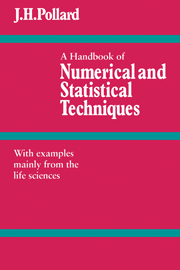Book contents
- Frontmatter
- Contents
- List of statistical and mathematical tables
- Preface
- PART I BASIC NUMERICAL TECHNIQUES
- PART II BASIC STATISTICAL TECHNIQUES
- 8 Probability, statistical distributions and moments
- 9 The normal and related distributions
- 10 The common discrete distributions
- 11 The Pearson system of probability-density functions
- 12 Hypothesis testing
- 13 Point and interval estimation
- 14 Some special statistical techniques
- PART III THE METHOD OF LEAST SQUARES
- Appendix
- References
- Author index
- Subject index
9 - The normal and related distributions
Published online by Cambridge University Press: 18 December 2009
- Frontmatter
- Contents
- List of statistical and mathematical tables
- Preface
- PART I BASIC NUMERICAL TECHNIQUES
- PART II BASIC STATISTICAL TECHNIQUES
- 8 Probability, statistical distributions and moments
- 9 The normal and related distributions
- 10 The common discrete distributions
- 11 The Pearson system of probability-density functions
- 12 Hypothesis testing
- 13 Point and interval estimation
- 14 Some special statistical techniques
- PART III THE METHOD OF LEAST SQUARES
- Appendix
- References
- Author index
- Subject index
Summary
Summary The normal, chi-square, t- and F-distributions all play prominent roles in statistical theory. The importance of the normal distribution is a direct result of the central limit theorem, and the other distributions are defined in terms of the normal. In this chapter, we summarise the important properties of each of these distributions. We also describe the log-normal distribution and the multivariate normal distribution.
The normal distribution
Random errors or fluctuations in the results of scientific experiments frequently follow a distribution which approximates the normal (or Gaussian) form. There are good reasons to expect this to be so. The central limit theorem states that the distribution function of a random variable which is the sum of n independent identically-distributed random variables with means μ and variances ρ2 approaches the normal distribution function with mean nμ and variance nρ2 as n becomes large. A particular variable which we measure is often the result of combining a large number of variables which we cannot or do not measure; the deviation of an observation from the mean value or expected value is thus a sum of a number of deviations, some positive and some negative, and often of comparable magnitude.
The normal distribution is a continuous distribution completely defined by its mean μ and variance ρ2.
- Type
- Chapter
- Information
- A Handbook of Numerical and Statistical TechniquesWith Examples Mainly from the Life Sciences, pp. 90 - 99Publisher: Cambridge University PressPrint publication year: 1977



